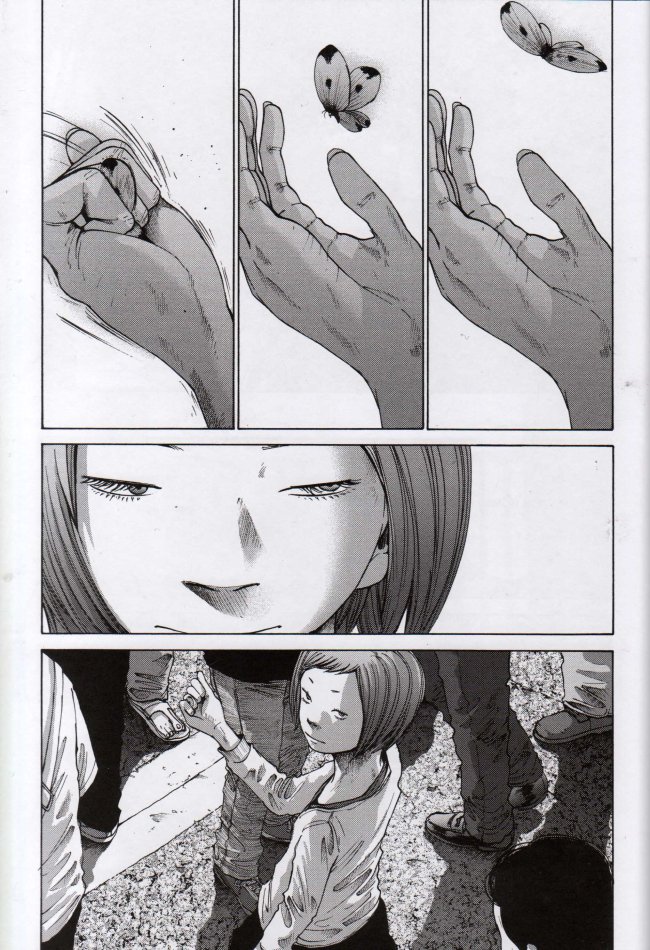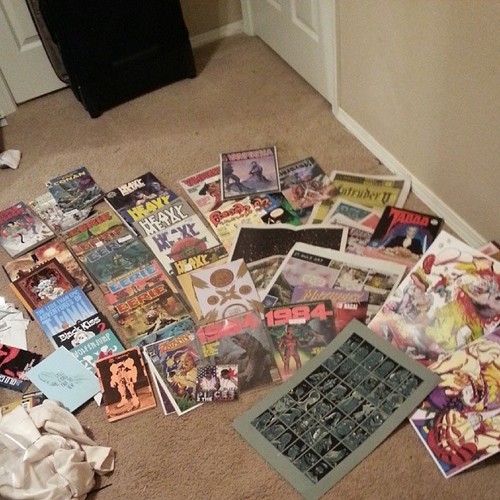
So yeah. I went to my first con ever this weekend. Like period, no comma. This was Emerald City Comic Convention C C C in Seattle, which I guess is like the third largest con in the country. I figure things like your first convention and impressions both on the artist side and on the wandering around looking at things side are the kinds of things writing is made for. So 10 years from now when I’m rocking spaghetti brains, there will be a record, sort of thing. Plus while I took some pictures I didn’t take a lot of pictures, so this is more like about all of the things between the pictures, which is everything.
That I went to ECCC was in no small part due to Brandon Graham keeping up on asking me if I was going to it, for like a year, and telling me how I really really needed to go, and making me feel bad for missing the one last year(where I missed out on Alison Sampson and Emma Rios for example). Not enough good can be said about Brandon. It would be impossible to even begin to say anything. I got to room with Brandon, Robin McConnell(Inkstuds), Simon Roy, Amika(Amy Clare), amongst others(like for instance Shannon, without whom Amika and I would still be lost somewhere in downtown Seattle). And as crowded as that sounds, it never was. Besides making really dope comics, one of the things that has been consistent throughout Brandon’s whole comics career has been this amazing ability to put houses/communities together. He is probably the most inclusive guy I’ve ever met. He is constantly trying to bring people together in comics and help build a newer doper more diverse place for dope comics to come from and go to. While some people sit up thinking about what boyhood fantasies they want to put in their X-men book Brandon I think sort of dreams of teaming of all of the different people he knows into the dopest books he can think of. It was really motivating to watch him work at the con and make legit time for everyone. Even though by the end, I swear his eyes were shifting in and out of focus like some kind of weird doppler effect.
Oni Party
I got in earlyish on Thursday which initially seemed like it was going to be a really awkward thing because I wouldn’t be able to check into my room until the Brandon/Simon and crew made it down to check in since the room was in their name. Initially I think my plan was just to chill in the airport for a few hours and then maybe hideout in the Sheraton lobby. But thankfully, because of the magic of twitter, I got in touch with Sandra Lanz who I’ve been friends with on the internets for minute, and she let me store my luggage in her room and hang out with her and Shawn. It ended up being a super big deal, because Sandra and I basically became con homies through the rest of the weekend. It’s one of those things that you can make a certain level of bond with someone through instagram photos and 140 character tweets, but when you actually get to meet them, you end up becoming serious friends. Sandra was kind of doing the same thing as me, which was kind of chilling a bit with friends who were working a booth but mostly interested in kind of roaming around at the con and going to panels and things. It was really great over the course of the weekend to talk to her about her comics and art, and what she wants to do with all of it. She’s an artist who has serious strengths in a lot of the areas where I’m really really weak, so I learned a lot picking her brain.
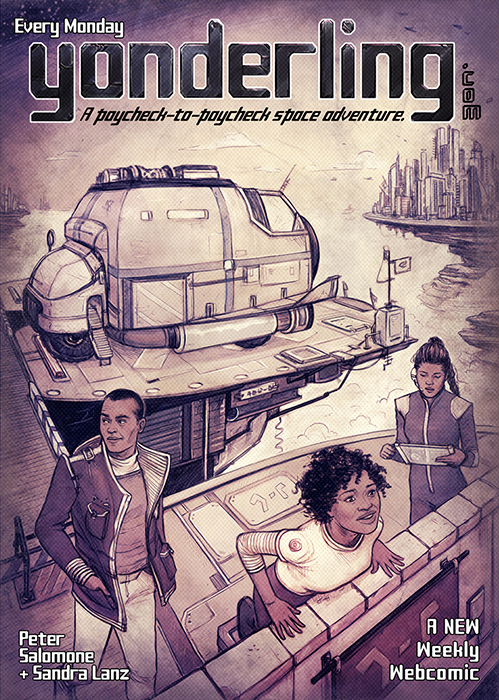
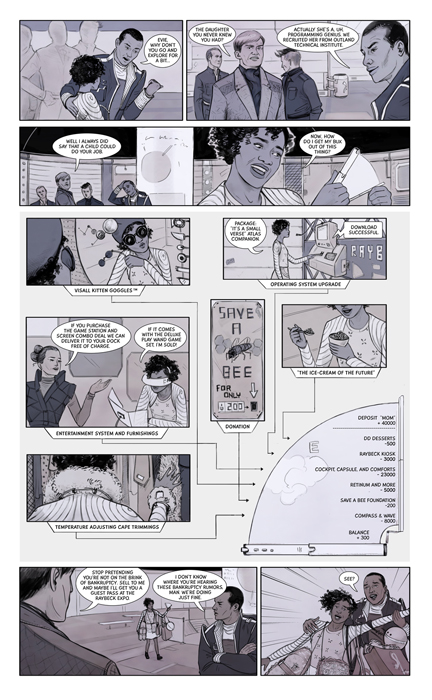
These are the cover and then an interior page from the webcomic she drew called Yonderling, which you can see ten pages of here. She’s mostly worked with other writers, but talking to her about her ideas artistically and what she wants to do, I really want to see her write some stuff too. Anyways, besides palling around for the rest of the con, the first night we roamed around the Oni Party with our sad hustle game of “Hey, I think that’s someone I know from the internet”. Fortunately this guy showed up:
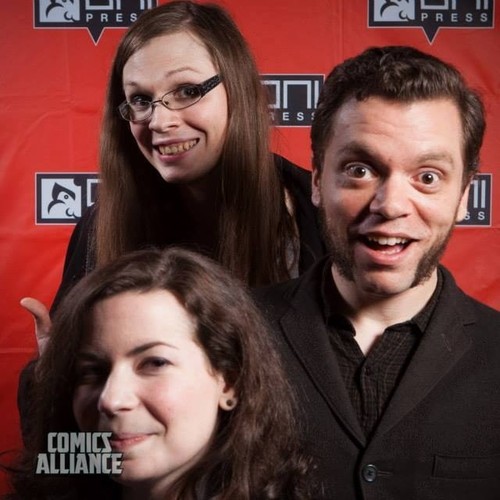
That’s me, Ian MacEwan, and Sandra.
Ian besides introducing large swaths of the modern comics world to deep heavy Moebius love through his old tumblr airtightgarage(which sadly is no more), and running the corpse project Think of a City with (friend of the show) Alison Sampson, is a really talented artist in his own right. His Study Group Comic with Jason Leivian(who I also met along with the predictably fantastic Zach Soto(comics bio: runs shit)) The Yankee is really good. Evidence:
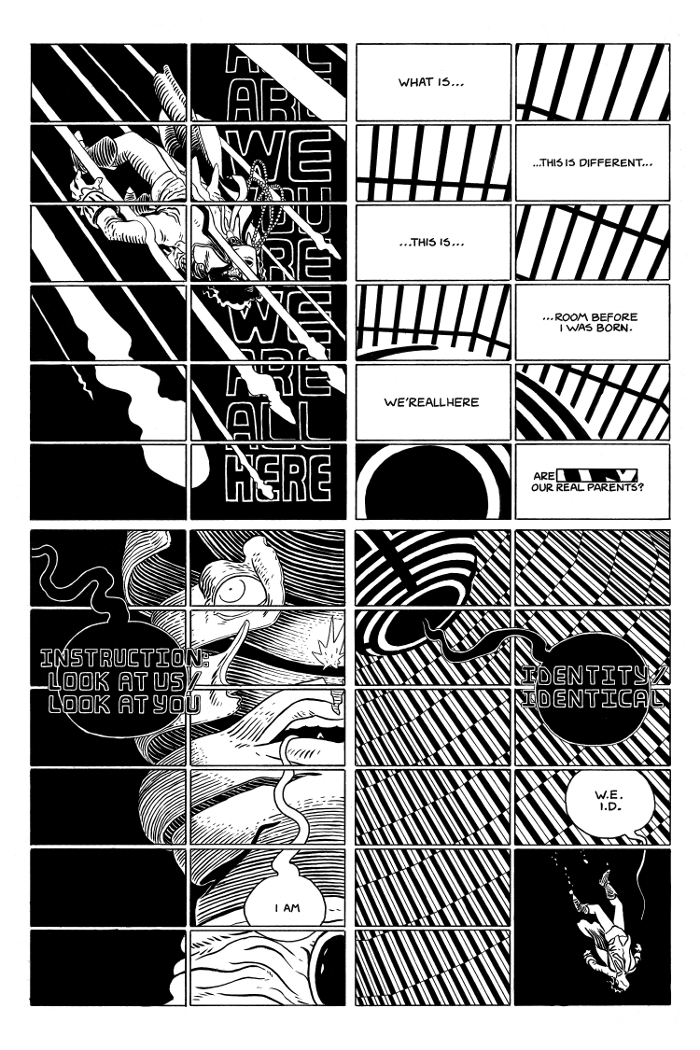
Ian was there to run the 2000AD booth, which despite really only having the stuff that’s been released in America from 2000AD was pretty much empty by the last day of the con. There’s a real thirst for that material I think, so hopefully more of it gets brought over. Or at least more of those Judge Anderson Arthur Ranson books. Ian is also just one of the nicest most knowledgable comics people you’ll run into. Anyways, met him at the Oni Party. Also met Andy Khouri who has been my editor at ComicsAlliance for the last two years. It was really cool to meet the flesh suit behind all the thousands of words I’ve thrown at him over the years. I also met Dennis Culver who in addition to writing all kinds of things, was just a super dope dude to me.
The other main thing that happened at the Oni Party was when these dudes rolled in:

This is Jen Vaughn, look how tall I am, and Jacq Cohen. And unfortunately the only picture I have with either of them despite both being highlights from the weekend as a whole. Jen and I were born in the same hospital and with Farel Dalrymple and Sterling Gates and a few others make up the super secret Oklahoma Comics crew who are quietly taking over prominent positions all through your comics industry. Jacq I’ve dealt with the last two years mostly on the critical writing side of things. She sends me great books and then I write about them, basically. She was also really encouraging about my comics as well. It was really cool to talk with her over the course of the weekend and hang out a little bit. She falls under the category of people who made the weekend feel way too short to spend as much time as I wanted with the people I dug. But I got pictures of baby bunnies in my phone, and went to this really great dinner and drinks she invited me and others to:
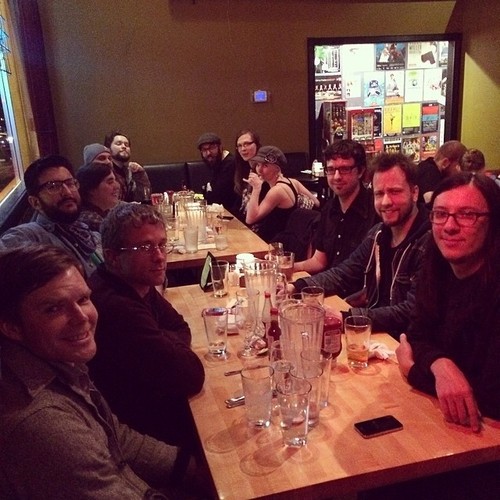
I like how this was just supposed to be about the Oni party, and now I’m all over the map in terms of time. This will be a special kind of hell to try and read through. Pace yourself.
Anyways. Eventually Brandan and the Canadians made it to the hotel, and I got my luggage shifted.
Day 1: Con Air
So like I said, because of the room situation, I got to use the Prophet table as a kind of homebase which was cool because there were a lot of cool people sort of around that table. Ed Brisson was over there, Johnnie Christmas, Michael Walsh, Corey Lewis, Damon Gentry, Aaron Conley, Joseph Bergin III were all over there in addition to Brandon and Simon. The dude who was running shit though was Con-Boss-Rick Ross Robin “Mr. Inkstuds” McConnell.
(Robin, Corey Lewis’ back, Damon Gentry’s Back, and I think an obscured Sandra Lanz)
I don’t know how anything would have gotten done without Robin. I think he was the only reason people knew when they were supposed to be at signings or panels. He organized what was a really small space, that could have easily ended up a complete mess with books and art getting stepped on and things spilled on. I figured out the first day as well that if I wanted to get any good comics at this con I had to follow Robin around. The first day I came back with like a vampirella and some esteban marotto zatanna comics, which…alright. Robin rolled back with these gorgeous Hermann Western comics and basically put me to shame. It’s safe to say me getting the comics I wanted at ECCC is almost entirely due to Robin’s almost supernatural ability to spot dope comics. Like I swear one time he saw a long box that had dope shit in it from like three booths away and through a crowd of people(there were 80,000 people at ECCC I think, I heard somewhere–it felt like that when you tried to walk or use the escalators, weirdly no one ever uses the elevators, so yeah). I’ve been listening to Robin’s podcast Inkstuds since maybe 2007? I first came across it looking for Paul Pope interviews to listen to, and I’ve been listening ever since. I think I’ve listened to almost every episode since I started listening, many from before. I’ve never really had a comics community or anything, so Robin gave me this window in this whole diverse world of people in comics, and what’s more the historical value of these documents through time can’t go without enough emphasis. For some of these artists this is the only real historical documentation of their lives that will be done with this level of sincerity–and it’s impossible to overstate what that is and what it means. I’m really excited for the big inkstuds roadshow that’s kicking up soon, even as I marvel at how these dudes(besides Brandon I think Simon Roy and Shannon Lentz are going too) find the reserves on top of the conventions, and just the normal work of making comics. And life. It is spectacular dedication to this comics thing. Beyond just the art form, it’s about the people behind that art form and the flesh and blood that makes it all possible. It is hard not to get hugely inspired by interacting with that kind of passion and intelligence. And I was really happy to do so.
The first day Sandra and I basically sat down circled some cool sounding panels and then did our best to find them through what was an almost labyrinthe designed convention. Over the course of the convention one of the things I began to notice was that almost 90 percent of the panels we ended up being interested in and going to either had David Brothers moderating or as an unnamed guest. David, besides being far and away the best dressed dude at the con, was basically like watching what it was like if a human being tried to be tweetdeck in real life. Like so many lists and columns scrolling through that dude at any given moment that it was like being next to the ECCC matrix watching him carry on intelligent conversation while downloading images for panels he would then go and moderate. His skills as a moderator really shown by contrast to the panels I saw that he didn’t do. It seems like part of a panel going well is having this good balance of targeted discussion and the spontaneity of audience conversation. The problem with the audience part is that it can be just about any kind of ill considered weird thing you can think of, and if a moderator doesn’t know how to handle that situation both strongly and politely, you end up with a situation like with the Self-Publish or Die panel which morphed into a strange and awkward digression through a very generalized discussion on Manga and Anime vs. Big Two Comics. But as good as his moderation was, I think it was his work actually ON the hiphop and comics panel that was the best.
I didn’t know what to expect with the hiphop and comics panel. I like both of those things. But the panel didn’t list the guests or the moderators, and I generally find there is quite a laughable sentiment between both hiphop and comics toward each other, with both being pretty stupidly basic in terms of their attempts to use the other. With hiphop perhaps handling comics better than comics has handled hiphop. So I kind of went in there with the idea that it was going to be terrible, and I would have something to laugh about later with Brandon. But I get in there and see David is on the panel, and if you follow David on the internet, you know one of the joys is whenever David writes about music, because he does it from such a personal vantage point that it’s always really cool to read. One of the things that the panel made me think about was about whether hiphop is in 2014 an aesthetic sensibility or if it is a mindstate. And I think I lean heavily on the latter. A lot of the aesthetics of what we might call “hiphop” at this point, are just antiquated pastiches that are goofy at best, offensive at worst. There was an interesting tension on the panel I think having Jim Mahfood who has kind of built his comic thing on pasting graffitti tropes over a fine arts lean, mostly situated around painting said aesthetic on attractive women…on a panel with two women graf writers who had just got back from a trip to Israel where they had been writing. And while I do really like Mahfood as an artist, it is actually probably like the klimt-edges of his work moreso than the hiphop/punk angles. I do think it’s interesting to think about his work as the idea of performing the idea of hiphop for a comics audience that is largely pretty dumb when it comes to hiphop. One of the highlights on that front was when Mahfood was talking about the role of style, and saying how if you didn’t have style you weren’t anything. And then the writer 137 chimed in that having no style was itself a style, and a thing unto itself. And while I don’t think it was supposed to maybe come off like a shot, in my head I definitely went “oooohhhhh shit”. So I don’t know. I think that selling hiphop as an aesthetic isn’t the same thing as BEING hiphop, or doing hiphop. Which brings us back to David Brothers, who isn’t a visual artist.
David talked about how for him hiphop was about ethics, way of living, way of approaching things, which helped him overcome mental health demons to go out and do the damn thing. Which I basically wanted to stand up in cheer. Because he put it into words pretty much exactly how I feel it. I mean…I’m writing this article write now while listening to Big K.R.I.T. I always write to hiphop. Why do I do that? I do that because even though many of the lyrics and ideas in hiphop are on the surface arrayed against me as a traswoman, the empowering swagger of hiphop and the ideas about ones community and art, are the only reason I am alive today, and the only reason I can write this, and the only reason I am the way I am about everything. Hiphop taught me moreso than any one other thing, how to live. And yeah…it was fantastic that David was on the panel to represent that point of view, because I think it is how it is with anyone who have lived a life through a backdrop of beats and rhymes. Style can be anything. Hiphop isn’t what you carry, it’s HOW you carry it. And it’s not something you can just fake. You’re either doing it or you aren’t. And it’s easy to see when someone doesn’t understand it and is just being a poseur to try and make a quick buck or get fake credentials in whatever it is they do.
Also Mahfood and Matthew Rosenberg were both wearing Bad Brains shirts.
After that panel, the first day ended, and I ended up going out to eat with Brandon, Simon Roy, Adam Warren, Amika, Joseph Bergin III, EK Weaver, and her husband voice actor Brett Weaver.
This introduces my other comic homie for the weekend Amy Clare or Amika. Amika is another vancouverite artist, who I knew through Brandon and the internet. I had only seen her illustration work to that point which is pretty amazing in it’s own right:
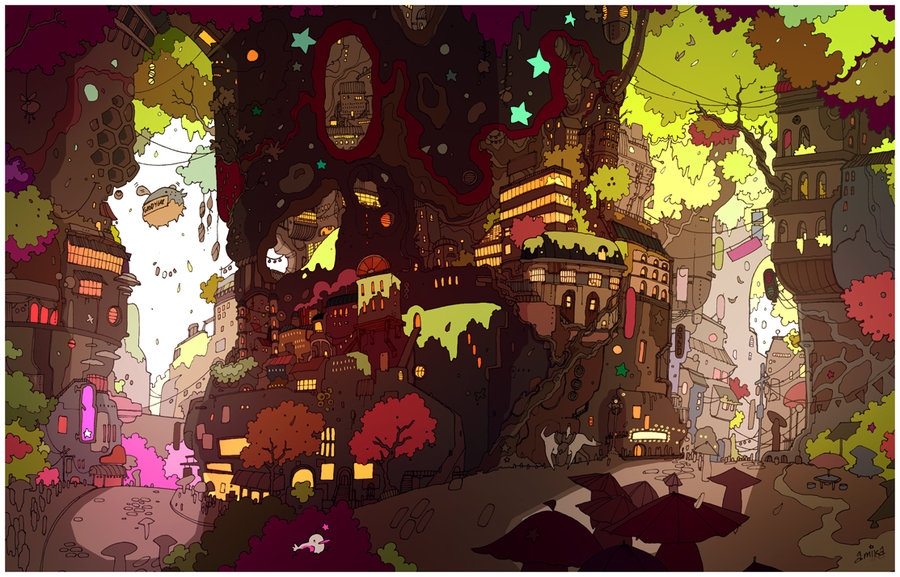
But I got to see her sequentials as well this weekend, and talk to her about what she wanted to do with comics…and yeah. She’s stupid talented. And I’m really excited for people to see comics from her. There’s this like really amazing two page spread I saw which, I can’t really describe, but I think everyone I forced it on while it was out had to double take the thing.
Beyond that, she’s just a really cool person to hang out with. With her only main vice being that she has a terrible sense of direction. Almost as bad as mine. Which I found out the first night when we tried to get back to our hotel and if not for randomly running into Shannon Lentz, we’d have ended up…well we’d probably still be somewhere in Seattle downtown today. We roved the con a ton the second day, and not because we went to a lot of things, but because we kept getting just amazingly lost. Like we crossed the damn sky bridge like 6 times in an hour. Did you know there’s a lower level at ECCC where there’s a sci-fi speed dating room? I didn’t either, until the 8th or 9th time we passed it like “hmm I think we’ve been here before”.
Amika also built this really amazing Princess Fortress in the room under one of the tables where she slept, and would sometimes talk like wizard of oz style as a disembodied voice. Also she had a sword, which she had to tell the ECCC people she wouldn’t use for evil. They tied this green tie thing on it, which made the sword, and I guess Amika by proxy “peacebound”. I don’t know why I didn’t take a picture of any of this. You can see Amika sitting next to me in the picture up toward the top of the dinner. Here she is with me and Damon Gentry:

Also at this dinner was THIS guy:
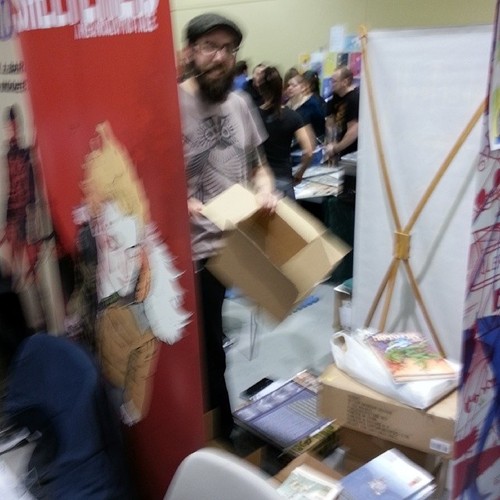
Joseph Bergin III. I know him mostly for the amazing job he does coloring Prophet. Which he was sat back looking like a proper artist all weekend hand coloring prophet artwork he had done. I got to sit next to Joseph at a few dinner party’s and have lots of cool conversations with him. He might be the nicest most thoughtful and considered dude I met at the thing which is saying something. If I get off my lazy butt, I will probably interview him for my website, because he’s really interesting in how he thinks about particularly color, and I have personally learned a lot the last few years from following random things that leak out about how he thinks about coloring in comics. He kind of reminds me a bit of some of the interactions I’ve had with Dean White in terms of the depth of consideration of art as a whole. Really cool and interesting dude.
Other days:
As you can see the days are kind of a blur to me and hard to seperate out. It isn’t helped that I pretty much slept maybe 4 hours a day, while being up and with people for the other 20 hours of the day. Plus if I wrote everything about what happened the way I did all of the above, it’d be like a novel. So some other highlights: talking about monorails with Farel, meeting and talking to Sterling Gates. I finally got to meet Sloane Leong in the flesh. She’s definitely way deep into that category of people I didn’t get to spend enough time with. It’s funny probably she and Brandon are the two people I spend the most time with on the interwebz, maybe, but I really didn’t hang out with either for as long as I did other people. I think it’s just like, I’m comfortable with both them enough, where it’s like, I dunno–we’re going to talk about it later kind of thing or something. I don’t know. I also finally met Ales Kot. I gave him a copy of my comic, which he seemed pleased with. It was cool to meet him finally. He’s a really happy positive dude. I also met Rory Morris of Wolfen Jump fame, who had to deal with me aimlesssly trying to find Esteban Morotto comics. I also met colorist/artist Marissa Louise who I am excited about talking with more. I also met the very talented James Scott and had a cool conversation about Berserk comics. Also showed him Abara which I’ve been carrying around in my purse for the past month.
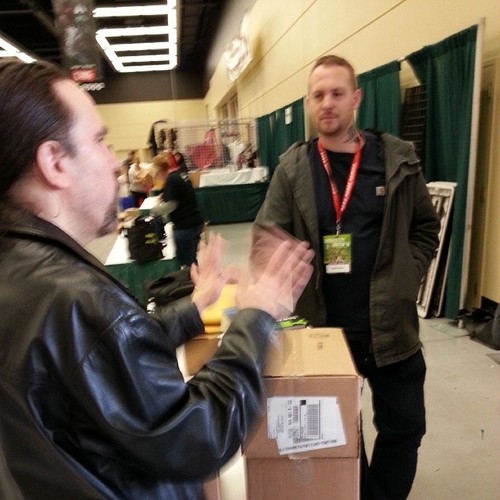
I got to talk with Adam Warren about comics. That was cool. I think I knew he read my tumblr or something. I was still surprised when he was like excited to meet me. His process posts, particularly on lettering are pretty much my school. He also makes dope comics himself, and one of the real panel highlights was when David Brothers had him and Brandon Graham breaking down Shirow fight scenes. I’ve always wanted to do that with artists. I’m not that interested in listening to artists speak about their own work–but I love to hear how artists see work that is important to them, because it’s almost like it’s own kind of projection of their perspective through a very focused prism. One of my favorite things this weekend was watching Brandon hang out with Adam Warren and EK Weaver. Even though he’s done all of these cons and been in the game a minute, and even though he’s basically exhausted and in a daze for most of the thing–the joy he has about meeting the people behind the comics he loves is amazing. And it’s cool too because Adam and EK I think were both very happy to talk with him as well. So it was just really adoreable, and just kind of speaks to a general vitality about how exciting great art is, and how important people are, and it sort of underscores that despite all of the best efforts of the comic’s industry to be a giant boot stamping people’s faces in, this thing is still all about people.
My sense about the whole convention is that while the booths and panels and everything are about at the end of the day making money, the real reason people come to this over and over, is because of the connection. Comics can be a very lonely pursuit. But every night I went down to the lobby and bar of the Sheraton and it was overflowing with noise and love. I don’t think I was alone in a lot of days just counting down the minutes till the con was over, so the real deal could start up again. The real deal was like being up until the lobby staff literally had tell everyone to leave so they could clean with a lobby full of happy to be around each other comic book people. People so tired they could barely keep both eyes open, probably sore all over from a day of standing and running around under various stress and pressure, but who basically still had to be pried out of each other’s company. There’s some sense of that kind of thing on twitter and facebook, but not to this extent. And that and how apparently I basically need to move to Portland, Seattle, and Vancouver concurrently was my main takeaway from the convention. I didn’t really find a bunch of amazing comics I couldn’t have found otherwise. But I did make stronger relationships with a lot of really amazing people, which was supremely amazing and flattering. I work and sort of live generally in such isolation out in Oklahoma, that it’s easy to forget that I can kind of do the people thing too, and sometimes people are okay too. Man, even my cab driver going back to the airport was like “you need to move here!”







